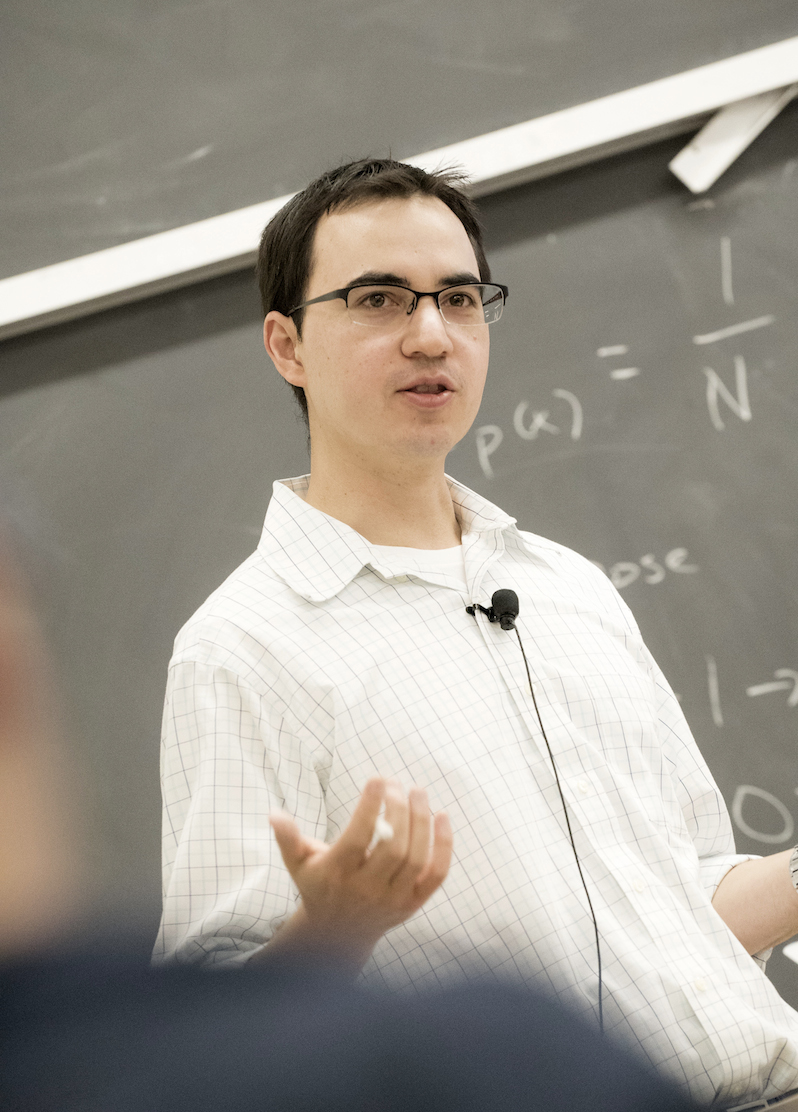
Associate Professor Michael Anderson teaches Applied Econometrics, a graduate course. Photo: Jim Block
Graduate Program Overview
Graduate work in economics demands a higher level of mathematical sophistication than most undergraduate economics programs would lead you to believe. Students entering the doctoral program are required to have completed a three-course sequence in calculus, a course in linear algebra, and a course in mathematical statistics. These prerequisites are a bare minimum.
Major Stages of the Program
In advancing to the Ph.D. degree, students pass through two major stages sequentially:
Preparation for candidacy: During the first three years, students complete courses to achieve competence in econometric methods and the fundamentals of microeconomic and macroeconomic theory. At least two courses must be taken from a selection of “core” courses dealing with topics in agriculture and resources. Students study for examination in a field of specialization of their choosing, and prepare a second year empirical paper. Preparation for candidacy culminates in an oral examination. When these steps are completed, students advance to candidacy.
Completion of a dissertation: The dissertation must be based on original research and represent a significant contribution to the body of economic knowledge.
Ag Resources Core and Ag Resources Certification: We’re not just economists, we’re Agricultural & Resource Economists. We expect our students to complete at least two courses from a selection of courses which focus on topics in agriculture & resources, both in low- and high-income countries. We call this set of courses the “Ag Resources Core.” Students who complete at least three courses in these courses will additionally be certified as Agricultural & Resource Economists. Some of these courses may be taken after the student advances to candidacy.
Overview of Program by Year
The entire process takes approximately five years, although some students are able to complete the program in less time. Below is an overview of program requirements by year and other pertinent information.
In the summer prior to starting the first year students complete Math 104, Introduction to Real Analysis. This course prepares students to write the mathematical proofs required in the first year. In the fall of the first year students take econometrics (ARE 210), microeconomic theory (ECON 201A), and production, industrial organization, and regulation in agriculture (ARE 201). In the spring semester of the first year students take econometrics (ARE 212), a second semester of microeconomic theory (ECON 201B), and agricultural economics (ARE 202).
First year courses provide an overview of mathematical tools, theoretical models, and associated concepts that are most relevant to applications in development, environment, resource, and agricultural economics. Students gain experience working with economic models, solving for the optimum or equilibrium outcomes, deriving comparative statics results, and extending workhorse models to fit problems/applications of interest.
In the summer before the second year students begin their second year econometrics projects, also known as the second year paper. Students select an economic question that is of interest to them, and under close faculty supervision craft an empirical paper. A good empirical paper requires three components: a concise, sensible, and relevant research question or hypothesis to test; reasonably good data; and an experiment, event, or set of circumstances that give the data a chance to answer the question asked. Identifying a good question is a non-trivial exercise that takes time and effort. Over the course of the second year students work with a faculty advisor to meet specific deadlines, and the top second year paper wins the Sidney Hoos prize.
Prior to the second year students should select a major and minor field area. Major and minor field areas include the following:
Additional minor fields are offered in conjunction with the Economics Department, Public Policy, and Haas School of Business.
The fall semester of the second year students take the second semester of econometrics (ARE 213), the econometrics project workshop (ARE 219A), an ARE field course, and a minor field course of their choosing. During the spring semester of the second year students complete the econometrics project workshop (ARE 219B), an ARE field course, and a minor field course. Since there are only three required courses in the Spring, many students opt to take a fourth course in Economics, Mathematics, Statistics, or another field during this time. The second year culminates in the major field exams.
Visit the online schedule of classes to see which major and minor field courses were recently offered.
The third year is devoted to preparing for oral examinations, which must be completed by the end of the third year, and finding a faculty advisor for the dissertation. We encourage students to begin discussing possible dissertation topics with faculty early on in their academic pursuit. After completing the written field examinations, students choose a faculty member to serve as advisor on developing a dissertation topic involving significant and original research. Students who have completed their orals exams are considered advanced to candidacy.
The student's progress through the program culminates in the writing of a doctoral dissertation which should be completed in the fourth or fifth year. The dissertation must be a novel contribution to economic knowledge, and a student who completes a dissertation is qualified to perform significant, independent economic research.

